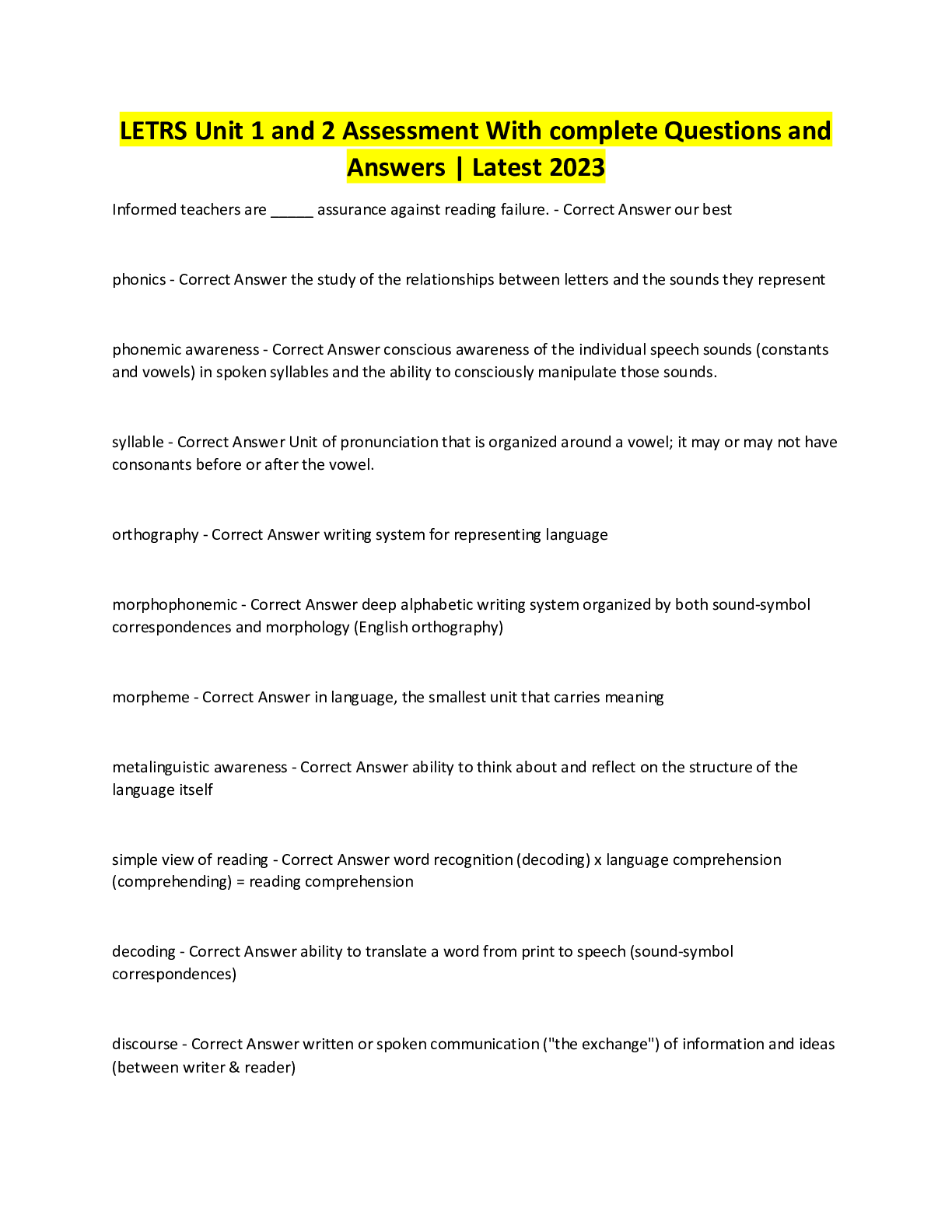*NURSING > EXAM > Rasmussen College :MDC4 Exam 2 Questions and Answers LATEST 2021/2022,100% CORRECT (All)
Rasmussen College :MDC4 Exam 2 Questions and Answers LATEST 2021/2022,100% CORRECT
Document Content and Description Below
lOMoARcPSD|8232526 Rasmussen College :MDC4 Exam 2 Questions and Answers LATEST 2021/2022 1. A client with a pulmonary embolism may have which of the following interventions? a. IVC filter b. Embol... ectomy c. Chest tube placement d. Heparin drug therapy e. Thoracotomy 2. An older adult client arrives in the emergency department after falling off a roof. The nurse observes “sucking inward” of the loose chest area during inspiration and a “puffing out” of the same area during expiration. Arterial blood gas results show severe hypoxemia and hypercarbia. Which procedure does the nurse prepare for? a. Chest tube insertion X b. Endotracheal intubation c. Needle thoracotomy d. Tracheostomy 3. A nurse in a burn treatment center is caring for a client admitted with severe burns to both lower extremities and is scheduled for an escharotomy. The client’s spouse asks the nurse what the procedure entails. Whish nursing statement is appropriate? a. Large, surgical incision will be made in the hardened dermal layer to improve circulation b. This procedure involves placing the client into a shower and removing the dead tissue c. A piece of healthy skin will be removed from an unburned area and grafter over the burned area d. Surgical incisions will be made into the deep tissue, possibly to the bone, to permit better circulation 4. A nurse is caring for a client who has burn injuries to his trunk. The nurse is explaining what to expect from the prescribed hydrotherapy. Which of the following statements by the client indicates an understanding of the teaching? a. I will be on a special shower table to enhance wound inspection and debridement b. The water temperature will be hot to improve blood flow and healing X c. The nurse will use a wire brush to remove loose skin d. The nurse will use scissors to open small blisters 5. Calculate the mean arterial pressure in mmHg for a client with a blood pressure of 84/46 mmHg. a. 59 mmHg 6. Which if the following interventions is not appropriate for a client diagnosed with a pneumothorax? a. Apply wet to dry dressing on wound b. Monitor respiratory and circulatory function c. Assess for tracheal deviation d. Provide analgesics 7. A client in the intensive care unit was recovering from moderate burns and smoke inhalation. His condition was improving, and plans were made to transfer him to a step- down unit. On the morning of the transfer, the client began to experience elevated temperatures and shortness of breath. Urine output decreased to 10ml/hr. labs were drawn and indicated elevated WBC, GFR, creatinine, and liver enzymes. The client is experiencing which medical complication? a. Acute respiratory failure X b. Acute kidney injury c. Disseminated intravascular coagulation d. Multiple organ dysfunction syndrome 8. A nurse is assessing a client who sustained superficial partial thickness and deep partial thickness burns 38 hours ago. Which finding should the nurse report to the provider? a. Edema in the burned extremities b. Severe pain at the burn site c. Urine output of 65ml/hr over 2 hours d. ABG pH 7.31, PaCO2 37 mmHg, HCO3 31 mEq/L 9. A nurse is caring for a client who has sustained burns over 37% of total body surface area. The client’s voice has become hoarse, a brassy cough has developed, and the client is drooling. The nurse should identify these findings as indications that the client has which of the following? a. Pulmonary edema b. Bacterial pneumonia c. Inhalation injury d. Carbon monoxide poisoning 10. A nurse is assisting the provider in caring for a client who has developed a tension pneumothorax. Which actions should be performed first? a. Assess the clients pain b. Prepare for large bore needle thoracostomy c. Administer lorazepam d. Prepare for chest tube insertion 11. When assessing a client who has suffered a burn injury, the nurse classifies the burn as a full thickness burn based on observing which characteristics? a. Painful, reddened skin b. Charred skin with milky areas c. Erythema and blisters d. Erythema, pain, and swelling 12. A client with 55% total body surface area burns arrives in the emergency department. The client weighs 160 #. Using the parkland burn formula calculate the hourly rate of lactate ringer during the first 8 hours of fluid resuscitation. a. 1000 13. A nurse is caring for a group of clients. Which client is at most risk for a pulmonary embolism? a. Client who has a body mass index of 24 b. An active postmenopausal female c. A long distance truck driver d. A client who consumes alcohol 14. After receiving report of four client, the nurse determines the order of care of the clients. Based on report, the nurse will prioritize the clients to see which one first? a. Newborn with mottling of extremities b. 72 year old with dry skin with tenting c. 35 year old athlete with bradycardia d. Healthy 18 year old with rapid shallow respirations 15. A client is receiving warfarin after pulmonary embolism. The nurse evaluates the lab results and notifies the physician that the clients warfarin level is therapeutic when which of the following numbers is reported? a. INR 2.8 b. PTT 24 seconds c. INR 1.1 d. PT 14 seconds 16. A nurse is assessing four clients. Which of the following clients should the nurse assess first? a. A client who has 2 rib fracture in 8/10 pain requestion pain meds b. An intubated client with a flail chest awaiting surgical fixation c. A client that has self extubated his endotracheal tube d. A client with a compound fracture and weak distal pulses 17. A client who has an endotracheal tube is being considered for a tracheostomy. Which of the following criteria would support the placement of a tracheostomy in this client? a. Client is unable to maintain airway when extubated b. Client has been on the ventilator for 24 hours c. Client has been diagnosed with diabetes d. Client is coughing and bucking the endotracheal tube X 18. The nurse is caring for a client who suffered a third degree burn to his hands after a house fire. He presented with an airway injury secondary to smoke inhalation and has been intubated. The client is surrently on the ventilator with 100% FiO2. Based on the information, which of the following would be a sign or symptom of acute respiratory distress syndrome? a. Respiratory rate 14 breaths per min b. Arterial blood gas results show PaO2 50 mmhg c. Fatigue and weakness d. Urine output 580 ml last shift 19. Which actions are essential for the nurse caring for a mechanically ventilated client to prevent ventricular acquired pneumonia? a. Keep the head of the bed elevated at least 30 degrees b. Perform oral care every 12 hours c. Prevent aspiration d. Suction every 1-2 hours around the clock e. Turn and reposition the client every 2 hours f. Prevent pressure ulcers around the mouth 20. The pathophysiology of acute respiratory distress syndrome is characterized by which of the following? a. Refractory hypoxemia b. Increased lung compliance c. Increased surfactant production d. Hypertension 21. During change of shift report, the nurse learns that a client has been admitted with dehydration and hypotension after having vomiting and diarrhea for 3 days. Which finding is most important for the nurse to report to the health care provider? a. Decreased bowel sounds b. Apical pulse 110 beats/min c. Pale, cool, and dry extremities d. New onset of confusion and agitation 22. When the charge nurse is evaluating the skills of a new RN, which action by the new RN indicated a need for further education in the care of clients with shock? a. Placing the pulse oximeter on the ear for a client with septic shock b. Keeping the head of the bed flat for a patient with hypovolemic shock c. Decreasing the room temperature to 68 F for a patient with neurogenic shock d. Increasing the nitroprusside (Nipride) infusion rate for a patient with high SVR 23. A nurse is reviewing the health records of clients. Which client is at least risk for developing acute respiratory distress syndrome? a. A client who experienced a near drowning incident in freshwater X b. A client following coronary artery bypass graft surgery c. A client who has hemoglobin of 10.1 mg/dl post 1 unit PRBC d. A client who is experiencing acute pancreatitis and vomiting 24. The provider ordered dopamine 20mcg/kg/min IV infusion. The bag is labeled dopamine 100mg/50ml. the client weighs 88 #. What is the infusion rate in ml/hr? a. 24ml/hr 25. A client is admitted to the emergency department with a full thickness burn to the right arm. Upon assessment, the arm is edematous, fingers are mottled, and radial pulse is now absent. The client states that the pain is 8 on a scale of 1 to 10. The nurse should perform which of the following? a. Administer morphine sulfate IV push for severe pain b. Call the healthcare provider to report the loss of the radial pulse c. Continue to assess the arm every hour for any additional changes d. Instruct the client to exercise the fingers and wrist 26. A nurse is teaching a client who has septic shock about the development of disseminated intravascular coagulation. Which statement indicates the nurses correct understanding of DIC? a. DIC is controllable with lifelong heparin usage b. DIC is a genetic disorder characterized by an elevated factor VII count c. DIC is caused by abnormal coagulation involving fibrinogen d. DIC is a genetic disorder involving a vitamin K deficiency 27. A client begins to show signs of shock. How should the client be positioned? a. With the head lower than the body b. Flat with legs elevated c. High fowlers position d. In a side lying position 28. The nurse is caring for a ventilated client. Which intervention is appropriate for this client? a. Ensure there is a manual resuscitation bag at the bedside b. Monitor the clients pulse oximeter reading every shift c. Assess the clients respiratory status every 8 hours d. Turn alarm volumes down to allow the client to rest 29. Which intervention will the nurse include in the plan of care for a client who has cardiogenic shock? a. Avoid elevating head of bed b. Check temperature every 2 hours c. Monitor breath sounds frequently d. Assess skin for flushing and itching 30. A client is being treated for distributive shock with IV norepinephrine. The nurse expects the drug to have which effect on the clients mean arterial pressure? a. Increased MAP with no change in vascular volume b. Increased MAP by increasing vascular volume c. Decreased MAP from widespread capillary leak d. Decreased MAP by decreasing vascular volume 31. A nurse is reviewing the health records of clients. Which client is at greatest risk for developing acute respiratory distress syndrome and multiple organ dysfunction syndrome? a. A client who experienced neurogenic shock b. A client who experienced anaphylactic shock c. A client who is experiencing septic shock d. A client who is experiencing obstructive shock 32. A client is being treated for hypovolemic shock. As the nurse reassesses the client, which finding indicates the interventions are effective? a. Oxygen saturations remain unchanged b. Core body temperature has increased to 99F c. Client incorrectly states the month and year d. Serum lactate and serum potassium level are declining 33. A nurse is assessing the fluid status of a client being treated for a burn during the emergent phase. Which of the following is an indicator of adequate fluid resuscitation? a. Blood pressure 90/60 mmhg b. Pulse 115 beats/minute c. Client confusion d. Urine output at least 30 ml/hr 34. A client in respiratory failure is diagnosed with a flail chest. After the client is intubated, which treatment does the nurse expect to be implemented? a. Positive end expiratory pressure (PEEP) b. Synchronized intermittent mechanical ventilator (SIMV) c. Bi level positive airway pressure (Bi PAP) d. Peak inspiratory pressure (PIP) 35. A nurse is caring for a client with arterial blood gas results pH 7.21, PaCO2 60 mmhg, PaO2 42 mmHg, HCO3 22mEq/L. which medication should the nurse prepare to administer? a. Antiemetic b. Hypoglycemic c. Corticosteroid d. Bronchodilator 36. When caring for a client who has early sepsis, which change in status is most important for the nurse to report to the health care provider? a. BP 100/56 b. Altered mental status c. Apical pulse 112 beats/min d. Arterial oxygen saturation 93% 37. Which information about a client receiving dobutamine to treat septic shock is most important for the nurse to communicate to health care provider? a. Clients heart rate is 108 beats/min b. Client is complaining of chest pain c. Clients peripheral pulses are weak d. Clients urine output is 15 ml/hr 38. A client with septic shock has a urine output of 20ml/hr for the past 3 hours. The pulse rate is 120 beats/min, and the venous pressure and pulmonary artery wedge pressure are low. Which of these orders by the health care provider will the nurse question? a. Give furosemide b. Increase normal saline infusion c. Administer hydrocortisone d. Prepare to give broad spectrum antibiotic 39. The client, who is 2 days postoperative following a pneumonectomy, has an apical pulse rate of 128 beats/min and a blood pressure of 80/50 mmhg. Which intervention should the nurse implement first? a. Document and continue to monitor b. Perform STAT ABG as ordered c. Prepare to administer dopamine, vasopressor as ordered X d. Increase the clients IV rate as ordered 40. A nurse is assessing a client who has fluid volume overload from cardiogenic shock. Which manifestation of cardiogenic shock should the nurse expect? a. Heart rate 121 beats/min b. Blood pressure 165/91 mmhg c. Respiratory rate 12 beats/minute d. Temperature 103.1 41. When assessing a client who is severely bleeding and at risk for hypovolemic shock, the nurse anticipates which of the following? a. Slow, labored breathing b. Hot flushed skin c. Edematous extremities d. Weak, thready pulse 42. The nurse is developing a care plan for a client in the acute phase of a burn injury. Which of the following would be the priority nursing diagnosis for this client? a. Risk for falls related to contracture of burned extremities b. Risk for infection related to slow healing graft donor site c. Risk for denial related to inability to participate in dressing change d. Risk for ineffective coping related to look at burn wounds 43. A nurse is educating a new nurse on the different types of shock. The new nurse is asked to identify which client is not experiencing distributive shock? a. Client with septic induced hypotension refractory to adequate fluid resuscitation b. Client with extensive spinal cord injury at T4 and a heart rate of 40 beats/min c. Client with an extreme type of allergic reaction to penicillin and stridor d. Client with tension pneumothorax and cardiovascular compression 44. Client with neurogenic shock is receiving phenylephrine infusion through a left forearm IV. Which assessment information obtained by the nurse indicates a need for immediate action? a. Clients IV infusion site is cool and pale b. Client has warm, dry skin on the extremities c. Client has an apical pulse rate of 58 beats/min d. Client’s urine output has been 28 ml over last hour 45. Which assessment is important for the nurse to evaluate whether the treatment of a client with anaphylactic shock has been effective? a. Pulse rate b. Orientation c. Blood pressure d. Oxygen saturation 46. Nurse recognizes indication of respiratory distress includes all the following except? a. Gasping b. Wheezing c. Stridor d. Stupor 47. Client with shock of unknown etiology whose hemodynamic monitoring indicates a blood pressure of 92/54 mm hg, pulse 64 beats/min, and an elevated pulmonary artery wedge pressure has the following collaborative interventions prescribed. Which intervention will the nurse question? a. Infuse saline at 250 ml/hr b. Keep head of bed elevated to 30 degrees c. Give nitroprusside unless systolic <90 mm hg d. Administer dobutamine to keep systolic >90 mm hg 48. Client has been prescribed silver sulfadiazine for a burn injury. Which of the following findings would give the nurse reason to question the order for this topical burn cream? a. WBC count of 10,000 per ml b. Client has a deep partial thickness burn wound c. Client has a sulfa allergy listed on the chart d. Client has a full thickness burn wound 49. Certified burn nurse is introducing a new nurse to the burn unit. The nurse is educating the new nurse on the degree staging of burns. Which of the following provides the correct description of a wound to the correct level of injury? a. Superficial thickness: reddened skin, desquamation, heals quickly without intervention b. Superficial partial thickness: pink, moist, blanching, some blistering is involved c. Deep partial thickness: blisters typically do not form, deep dermal injury, may need grafting d. Full thickness: epidermal and dermal layers are destroyed, development of eschar 50. Nurse is caring for a client experiencing hypovolemic shock. Which of the following interventions would not be appropriate for this client? a. Monitor intravenous fluid replacement b. Monitor vital signs c. Monitor hemoglobin and hematocrit levels d. Assist to a sitting position 51. The emergency department nurse is assessing a client who has sustained a blunt injury to the chest wall. Which finding would indicate the presence of pneumothorax in this client? a. Low respiratory rate b. Diminished breath sounds c. Presence of barrel chest d. Sucking sound at the site of injury 52. Nurse is assessing the respiratory status of a client who has suffered a fractured rib. The nurse should expect to note which finding? a. Slow deep respirations b. Rapid deep respirations c. Paradoxical respirations d. Pain, especially with inspiration 53. Nurse is caring for a client who is in hypovolemic shock related to hemorrhage. The nurse prepares IV tubing to infuse with which IV solution in preparation for a blood transfusion? a. 0.45% sodium chloride/ b. Lactated ringer’s solution c. Dextrose 10% in water d. 0.9% sodium chloride 54. Client presents with the following vital signs: blood pressure 90/60 mm hg, temperature 38.3C (101F), heart rate 116 beats/min, respiratory 24 breaths/min. the client has a post-op abdominal incision that is warm and red. Which type of shock is this client in? a. Hypovolemic shock b. Septic shock c. Anaphylactic shock d. Neurogenic shock 55. Nurse is caring for a client being treated with mechanical ventilation. The ventilator sounds a low pressure alarm. The nurse immediately assess for other signs of which condition? a. Right pneumothorax b. Pulmonary embolism c. Disconnected endotracheal tube d. Acute respiratory distress syndrome 56. Client with a chest injury has suffered a flail chest. The nurse assesses the client for which most distinctive sign of flail chest? a. Cyanosis b. Hypotension c. Paradoxical chest movement d. Dyspnea, especially on exhalation 57. Nurse is planning care for a client who has severe acute respiratory distress syndrome (ARDS). Which actions should the nurse include? a. Aggressive fluid therapy and diuretics b. Administer antiviral and antibiotics for every cause of ARDS X c. Assess lungs daily and hourly suction to maintain airway d. Maintain intubation and mechanical ventilator support. 58. Which of these findings is the best indicator that the fluid resuscitation for a client with hypovolemic shock has been successful? a. Hemoglobin is within normal limits b. Urine output is 60 ml over the last hour c. Pulmonary artery wedge pressure is normal d. Mean arterial pressure is 65 mm hg 59. Nurse is caring for a client who is in the progressive stage of shock. Which finding should the nurse expect? a. Blood pressure change from 129/78 (95) mm hg to 89/45 (60) mm hg b. Blood pressure change from 95/55 (65) to 90/52 (65) c. Blood pressure change from 100/50 (67) to 90/45 (60) d. Blood pressure reading is undetectable 60. Nurse is evaluating the lab values of a client who is in the resuscitation phase following a major burn. Which of the following lab findings should the nurse expect? a. Hemoglobin 10g/dL X b. Sodium 143 c. Albumin 2.9 d. Potassium 4 61. Nurse is planning care for an adult client who sustained severe burn injuries. Which interventions should the nurse include in the plan of care? a. limit visitors in the clients room when immunosuppressed b. encourage raw foods to improve exposure to natural flora c. offer high calorie, high protein foods or supplemental feeding d. ambulate 2 or 3 times a day and progress in length each time e. apply compression dressings before the graft heals to prevent scar formation 62. nurse is caring for a client in shock. The nurse understands the client’s sympathetic nervous system is still correctly attempting to compensate when the following is assessed? a. Client has decreased peripheral pulses b. Client has an increase thirst c. Client has decreased heart rate d. Client has an increased respiratory rate e. Client has widening pulse pressure 63. Burn client is brought into the emergency department with the following burns: half of the front torso, entire left arm, front of the left leg. The nurse should record the total body surface area burn as? a. 27% b. 35% c. 20% d. 40% 64. Client is treated in the emergency department for shock of unknown etiology. The first action by the nurse is which of the following? a. Administer oxygen b. Attach a cardiac monitor c. Obtain a blood pressure d. Check level of consciousness 65. Client has been diagnosed with pulmonary embolism. Which diagnostics and treatments does the nurse anticipate will be ordered? a. D dimer b. Thrombolytics c. Atropine d. Nitroglycerine e. CT angiogram 66. Nurse is managing several IV medications to maintain the blood pressure of a client in hypovolemic shock. Which medication places the client at risk for a hypertensive reaction, requiring the nurse to assess the blood pressure at least every 15 minutes? a. Norepinephrine b. Sodium nitroprusside X c. Adenosine d. Amiodarone 67. Nurse is caring for a client who is receiving mechanical ventilation via an endotracheal tube. Which of the following actions should the nurse take? a. Apply a vest restraint if self extubating is attempted b. Monitor daily ventilator settings c. Document tube placement in inches at the angle of the jaw d. Assess breath sounds every 4 hours 68. Client who is one day post-op following chest surgery, is having difficulty breathing, has bilateral rales, and is confused and restless. Which intervention should the nurse implement first? a. Give inhaled nebulizer treatment as ordered b. Notify the rapid response team c. Place the client in Trendelenburg position X d. Check the clients surgical dressing 69. Postop client reports a sudden onset of shortness of breath and pleuritic chest pain. Assessment findings include diaphoresis, hypotension, crackles in the left lower lobe and pulse oximetry of 85% on room air. What does the nurse suspect has occurred with this client? a. Atelectasis b. Pneumothorax X c. Pulmonary embolism d. Flail chest 70. Client presented to the ED after receiving second and third degree burns from a kitchen grease spill. The tops of both thighs, the groin area, and lower abdomen were the areas of injury. About 3 hours after the injury, the client begins to decompensate and is being prepped for intubation. Regarding the change in client status, which explanation by the nurse is correct when educating the clients family? a. Client is complaining of severe pain and will be intubated to safely give pain medications and sedatives b. Client is experiencing a paralytic ileus and requires intubation to prevent further damage c. Even a burn as little as 25% of the body can cause a systemic response, requiring emergency management d. Fluid shifts in the body immediately cause an increase cardiac output and increase tissue perfusion, which can negatively affect the healing process X 71. Client with a possible spinal cord injury is admitted to the emergency department. Which finding by the nurse will help confirm a diagnosis of neurogenic shock? a. Skin is warm and dry b. Inspiratory crackles c. Apical heart rate 48 beat/min d. Stabbing pain in the extremities 72. Client arrived at the burn unit more than 2 weeks ago. The care plan for this client requires assistance by the nurse to perform daily range of motion exercises and help with mobility. The client tells the nurse he will no longer participate due to the pain it always causes. Which of the following should the nurse do next? a. Call the doctor to report noncompliance with treatment b. Remind the client that contractures hurt worse and to let the nurse know when he is ready c. Give the client his ordered PRN dose of IV hydromorphone 4mgs with his scheduled PO oxycodone 10 mg 30 prior to treatment to allow for pain free therapy d. Acknowledge the clients concerns regarding pain and discuss how to promote his exercise plan in a way to have less pain but also allow therapeutic level of treatment 73. Intensive care unit nurse is caring for a client. The ventilator alarms are sounding. Which interventions should the nurse implement first? a. Notify respiratory therapist immediately b. Ventilate with manual resuscitation bag c. Check the ventilator to resolve the problem d. Auscultate the client’s lung sounds 74. Nurse is caring for a client who is in the nonprogressive compensatory stage of hypovolemic shock. Which finding should the nurse anticipate? a. Multiple organ dysfunction and seizures b. Increased thirst reflex and moderate vasoconstriction c. pH 7.5 and potassium level of 3 d. decrease in mean arterial pressure MAP by 20 points form baseline X 75. client with neurogenic shock has just arrived in the emergency department after a diving accident. Ha has a cervical collar in place. Which of the following actions should the nurse take? a. Prepare to administer atropine IV b. Obtain baseline body temperature c. Prepare for intubation and mechanical ventilation d. Administer large volumes of lactated ringer solution e. Assist the client into semi fowlers position [Show More]
Last updated: 1 year ago
Preview 1 out of 13 pages
Instant download
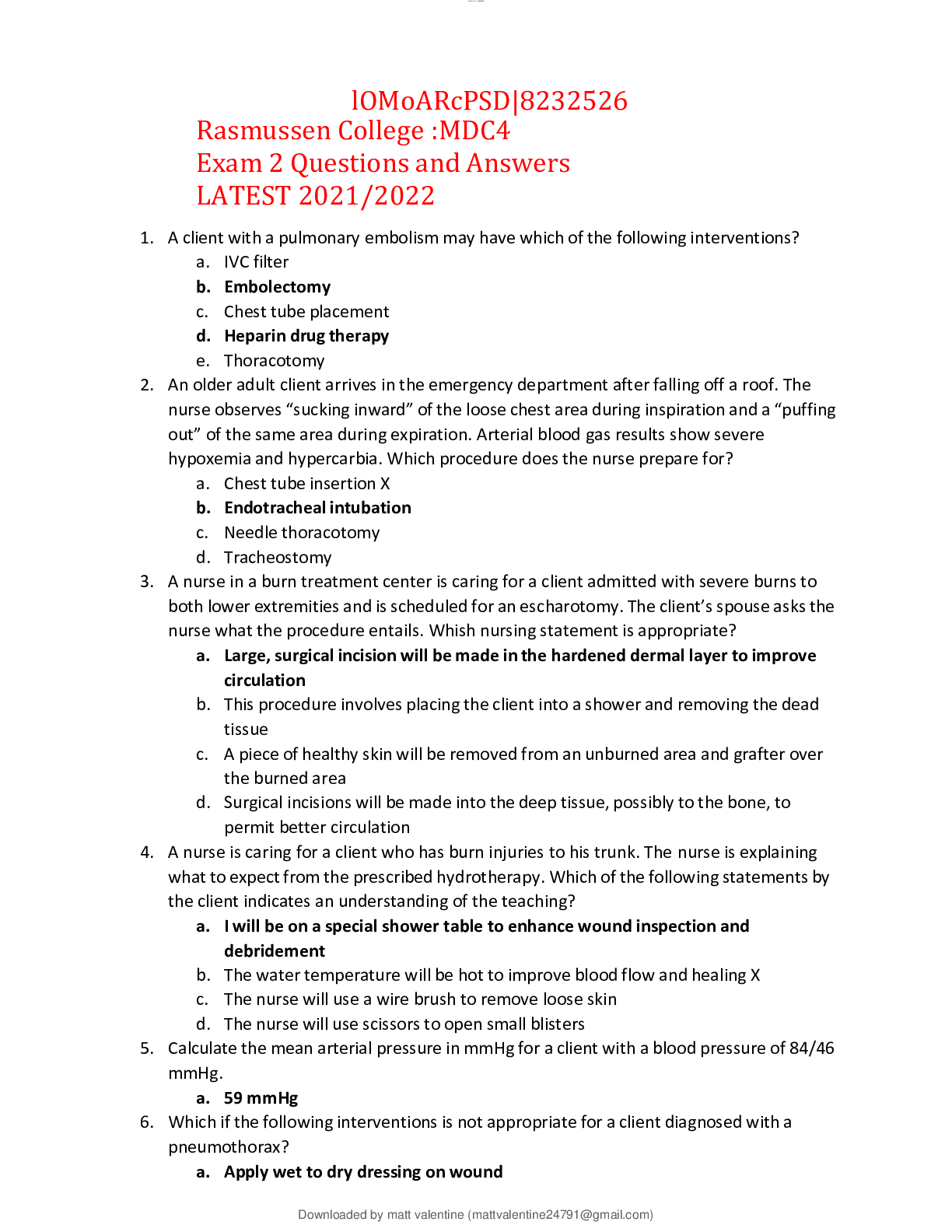
Instant download
Reviews( 0 )
Document information
Connected school, study & course
About the document
Uploaded On
Feb 16, 2022
Number of pages
13
Written in
Additional information
This document has been written for:
Uploaded
Feb 16, 2022
Downloads
0
Views
33














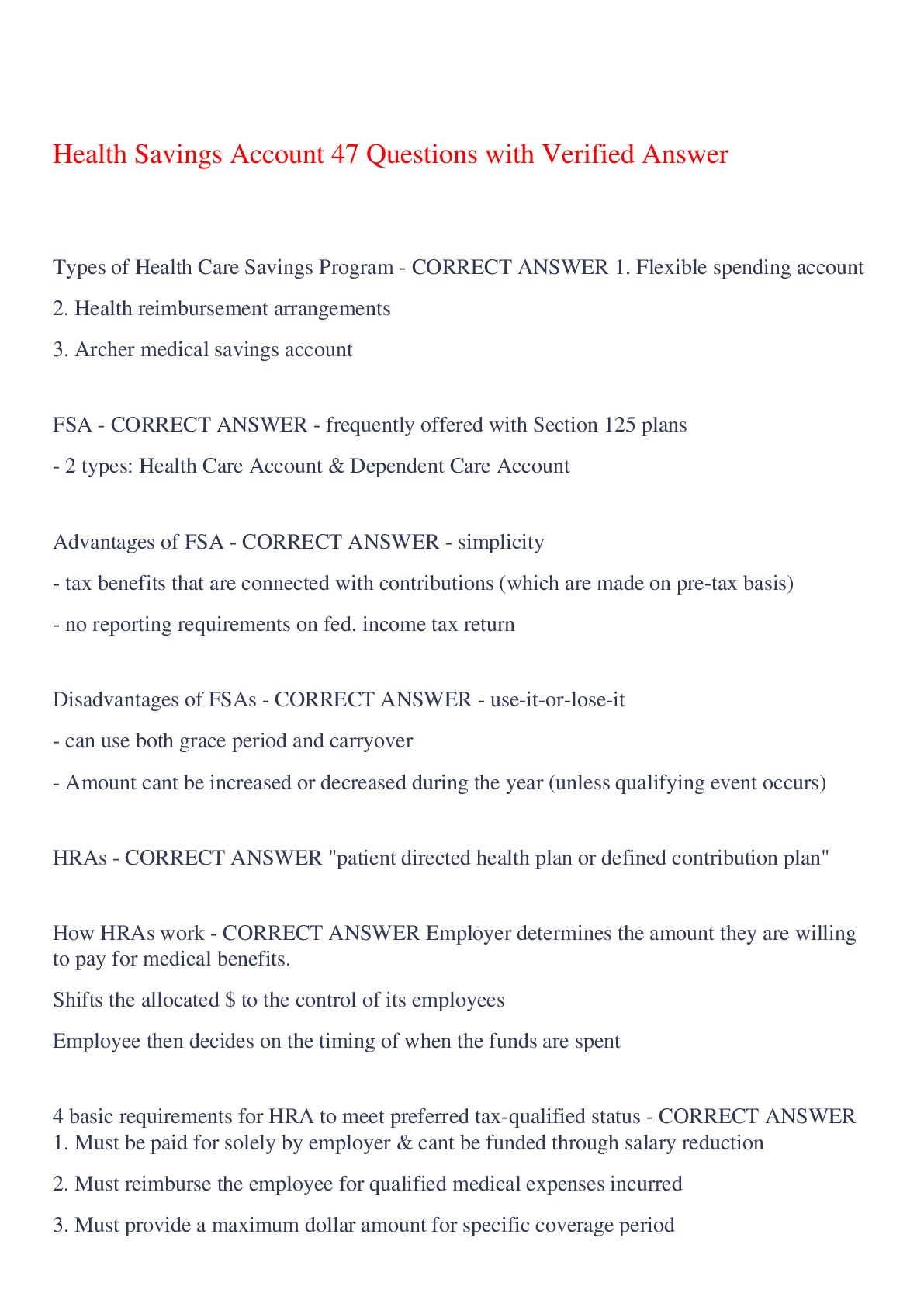



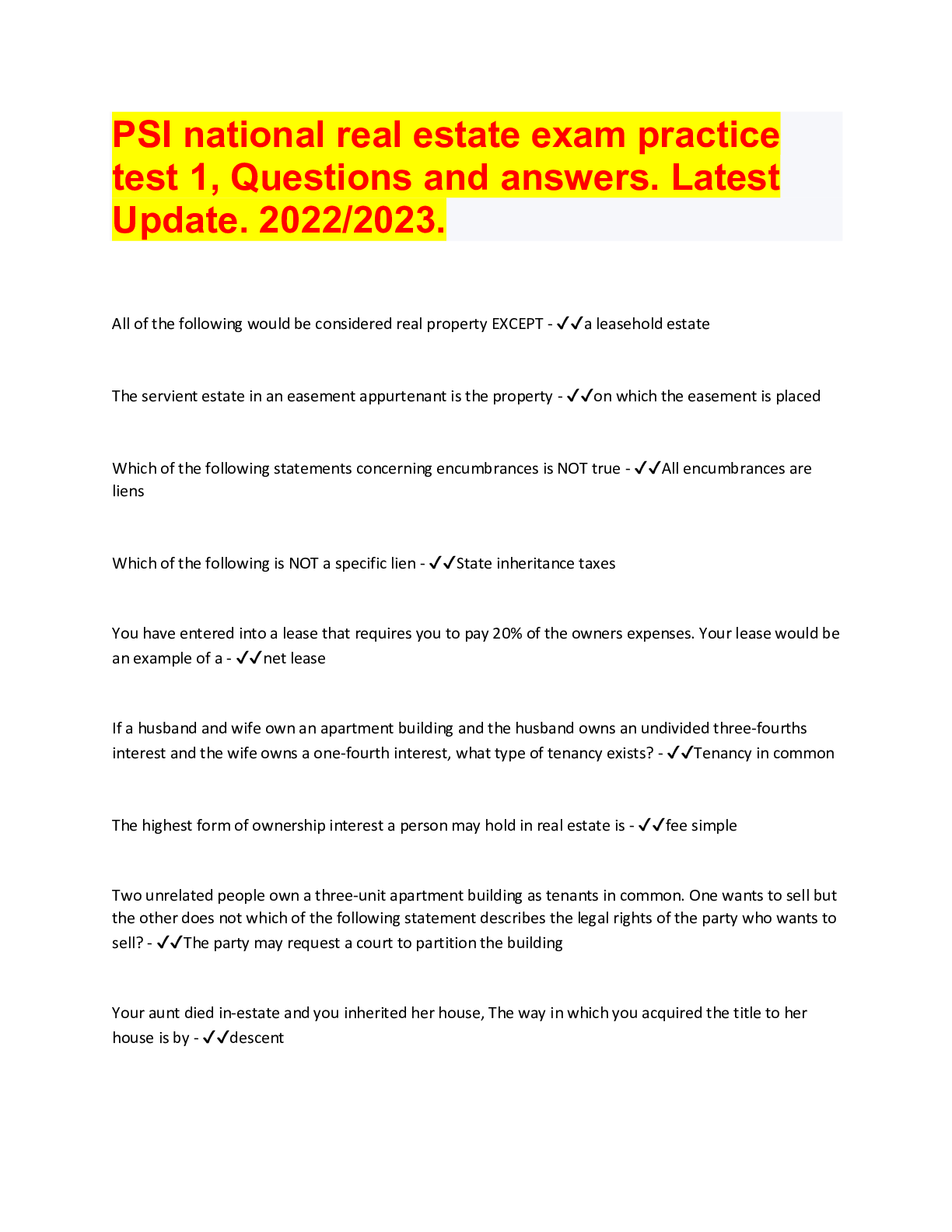



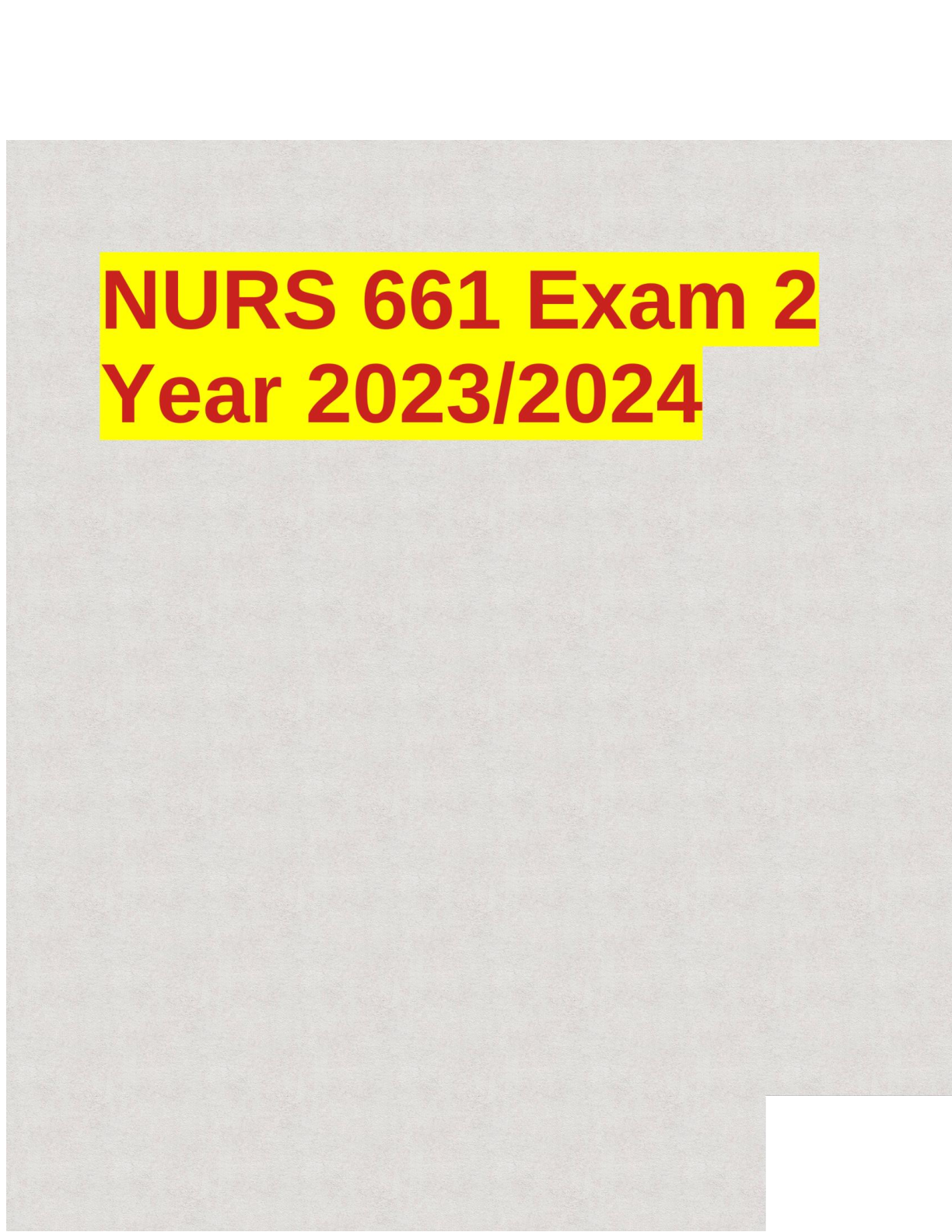



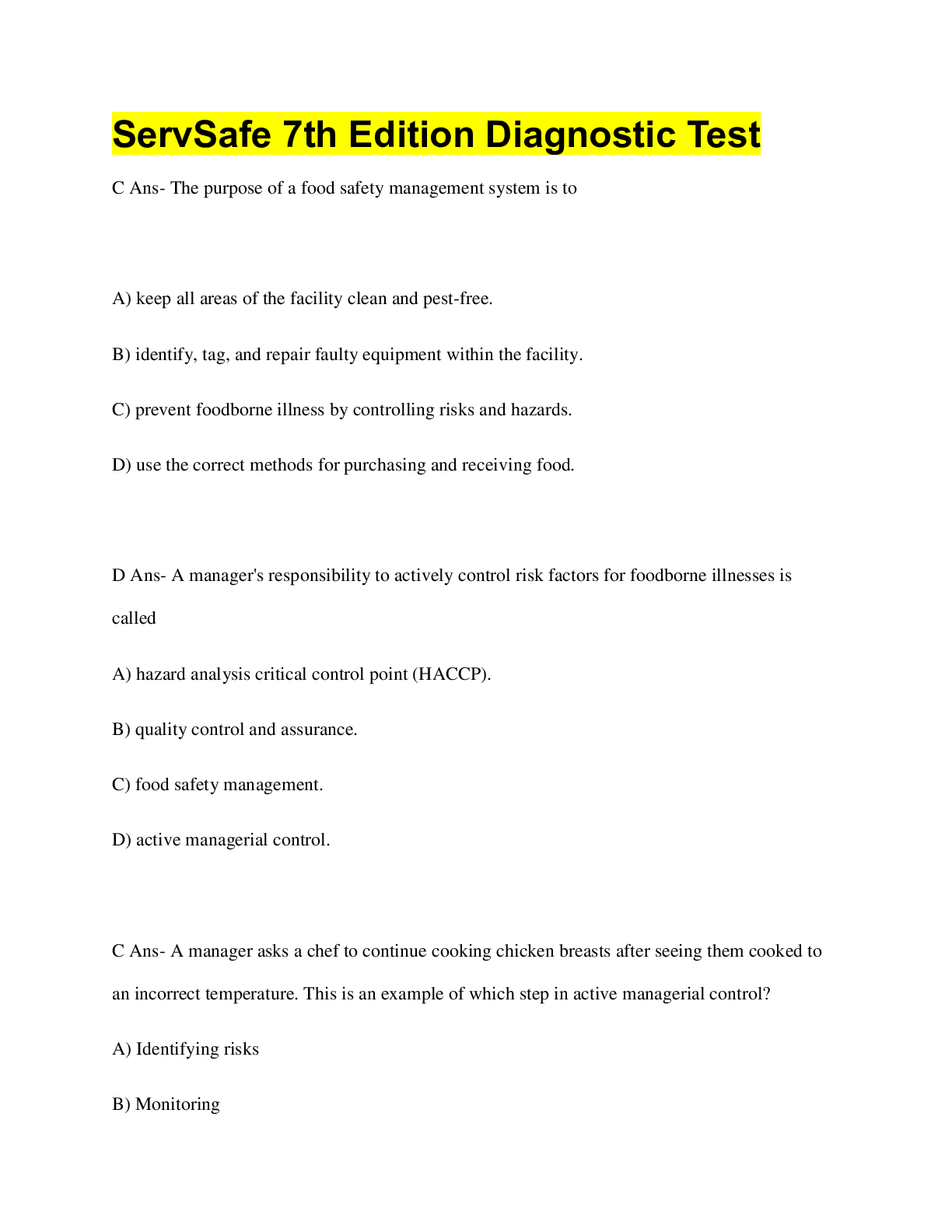
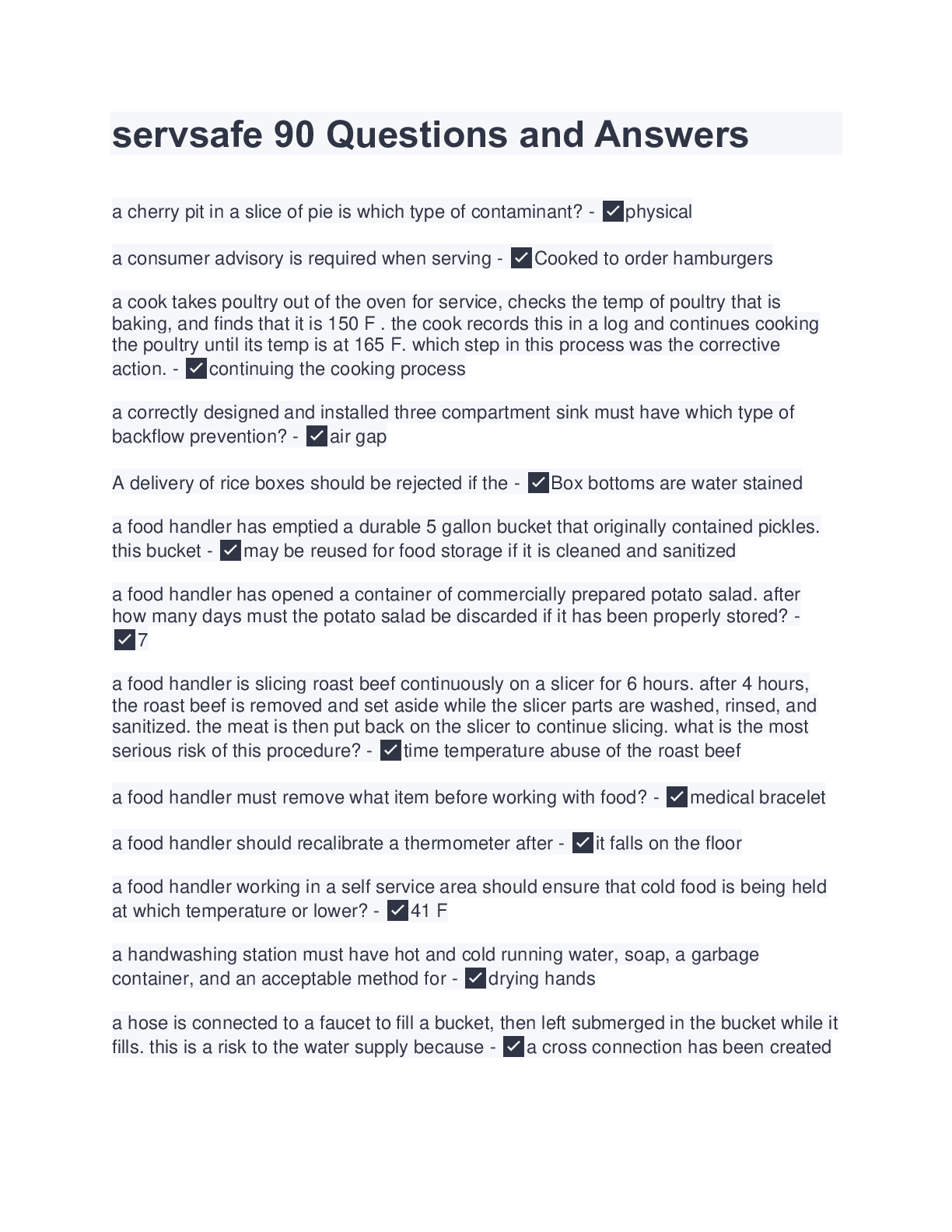
.png)







